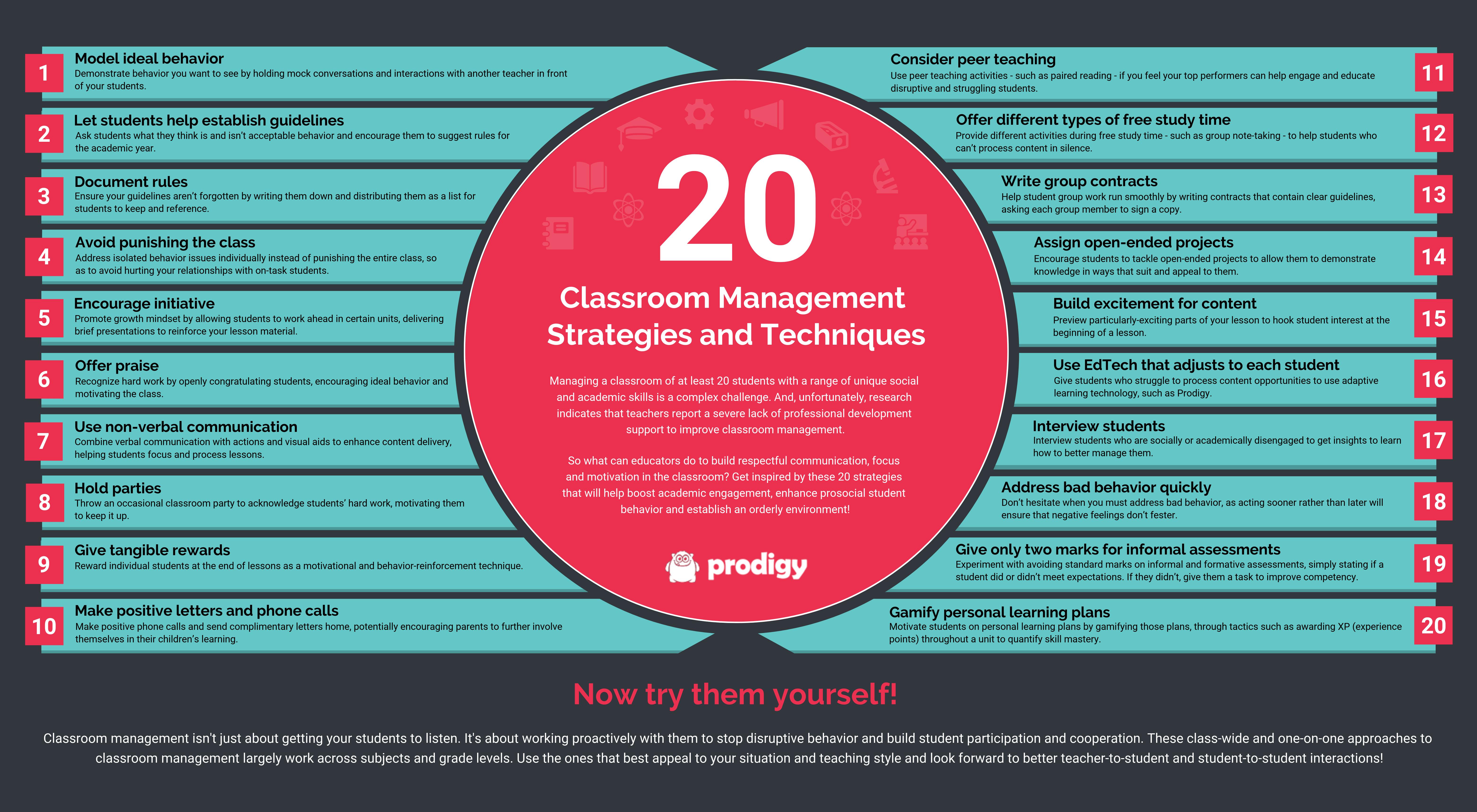A willingness to bring new teaching strategies into your lesson plan is one of the best qualities a teacher can have.
In Effective Teaching and Learning, educational researcher Naga Subramani argues that an effective teacher:
“Constantly renews himself [or herself] as a professional on his [or her] quest to provide students with the highest quality of education possible. This teacher has no fear of learning new teaching strategies or incorporating new technologies into lessons.”
Is that you?
Try new teaching strategies with Prodigy, a no-cost, adaptive math platform. Get started today!
There’s more than one way to teach a diverse and dynamic classroom. In this post you’ll find:
- A comprehensive list of 36 teaching strategies to use in math class and beyond
- A list of essential resources for using them effectively
Classroom teaching strategies and techniques
1. Classroom management strategies
Infographic: 20 Classroom Management Strategies and Techniques. Click to expand!
According to research from 2006, teachers overwhelmingly reported a lack of professional development support when it came to improving their own classroom management strategies. This can lead to confusion for students and frustration for teachers.
When students clearly understand what’s expected of them, they’re more likely to be focused and engaged with their lessons. Some tips for building a positive environment include:
- Model ideal behaviour: Clearly explain proper behaviour, and then follow it yourself.
- Encourage initiative: Allow students to actively participate in the learning process with class discussions and exercises that support the initiative.
- Avoid collective punishment: While it can be difficult, make a point of calling out disruptive behaviours on an individual, not collective, basis.
- For more actionable classroom management teaching strategies, read 20 Classroom Management Strategies and Techniques [+Downloadable List].
2. Flexible seating
Kristine Fourman, a teacher in the Bucyrus Elementary Preschool Program, connects student seating and academics: “When students aren’t trying to hold themselves still in their chairs, they can integrate auditory, visual and tactile systems of the body.”
There are so many different ways to incorporate flexible seating into your classroom in a way that fits with your students’ learning goals. For examples and best practices, read Flexible Seating: 21 Awesome Ideas for Your Classroom.
3. Webb's Depth of Knowledge
Norman Webb’s Depth of Knowledge (DoK)is familiar to many teachers from a theoretical perspective, but it can be incredibly difficult to apply practically and consistently in your teaching strategies.There are four DoK levels:
- Level one: Recollection and reproduction
- Level two: Knowledge application
- Level three: Strategic thinking
- Level four: Extended critical thinking
There are a number of engaging activities that can promote different DoK levels: read more about them in Specific Ways to Use Webb’s Depth of Knowledge in Class.
4. Summative assessmentSummative assessments are end-of-unit tests, final projects or standardized tests used to assess student understanding on a broad and absolute level.
Critics of summative assessments say they’re inauthentic and don’t accurately reflect the learning process. But there are important benefits to using summative assessments as a teaching strategy: they motivate students to pay attention and challenges them to apply their learning. They’re also a valuable source of insight for teachers, especially for those with larger classes -- allowing them to easily identify and correct any wide gaps in understanding across the classroom.
Don’t be afraid to get creative when making summative assessments! Read Summative Assessment: A Comprehensive Guide for ideas on how to get students engaged with the testing process.
5. Formative assessment
Formative assessments are the opposite of summative assessments because they take place during the teaching process.
Formative Assessment
- Occurs through chapter or unit
- Improves how students learn
- Covers small content areas
- Monitors how students are learning
- Focuses on process of student learning
Summative Assessment
- Occurs at end of chapter or unit
- Evaluates what students learn
- Covers complete content areas
- Assigns a grade to students’ understanding
- Emphasizes the product of student learning


Post a Comment